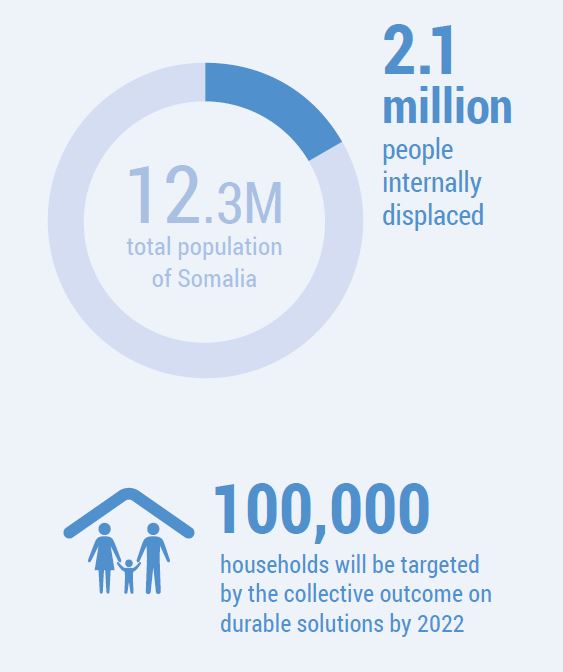Overview
 Devastating protracted dry spells over the last 25 years, unprecedented drought spanning the last four rainy seasons and ongoing conflict have severely aggravated vulnerability in Somalia, and humanitarian needs continue to rise. Along with the goal of scaling up recovery and development action in Somalia, the Government and its partners have committed to strengthening synergies between humanitarian and development action, in line with the New Way of Working. They have developed four collective outcomes to strengthen coherence and complementarity between humanitarian and development efforts, and to ultimately reduce needs and vulnerabilities.
Devastating protracted dry spells over the last 25 years, unprecedented drought spanning the last four rainy seasons and ongoing conflict have severely aggravated vulnerability in Somalia, and humanitarian needs continue to rise. Along with the goal of scaling up recovery and development action in Somalia, the Government and its partners have committed to strengthening synergies between humanitarian and development action, in line with the New Way of Working. They have developed four collective outcomes to strengthen coherence and complementarity between humanitarian and development efforts, and to ultimately reduce needs and vulnerabilities.
Collective outcomes
- Food insecurity: By 2022, the number of people in acute food insecurity decreases by 84 per cent, with Global Acute Malnutrition (GAM) rates reduced by 5 per cent and sustained below the emergency threshold.
- Durable solutions: Risk and vulnerability reduced and resilience of internally displaced persons, refugee returnees and host communities strengthened in order to reach durable solutions for 100,000 displaced households by 2022.
- Basic social services: Number of vulnerable people with equitable access to inclusive basic social services increases by 27 per cent by 2022.
- Climate-induced hazards: Proportion of population affected by climate-induced hazards (drought and flood) reduces by 25 per cent by 2022.
Where do we stand?
In January 2018, the humanitarian and development communities in Somalia agreed on four collective outcomes to ensure alignment and complementarity between the Humanitarian Response Plan and the Recovery and national Resilience Framework (RRF).
Some of the broad steps taken:
-
Formation of a technical group to agree on realistic and measurable collective outcomes
-
Identification of outcomes based on Humanitarian Needs Overview and Drought Impact Needs Assessment
-
Specifying the scope of each outcome, as well as targets and indicators
-
Agreement on the scope of each outcome by HCT and UNCT and presentation to Government
Lessons learned
Collective outcomes need to be articulated at the earliest stage in order to drive any subsequent planning process. Wherever possible, informed by a truly joint analysis, collective outcomes should become the driver and determinant factor for how programmes are designed, funded and implemented over a period of 3-5 years.
It is important to identify the key actors and relevant coordination forums (on both the humanitarian and development side) as early as possible. In Somalia, the process is being undertaken via the Humanitarian Country Team and national development coordination mechanism (Somalia Development and Reconstruction Facility – SDRF) which bring together all the key actors. Two pillar working groups from the SDRF were identified as being relevant for this exercise: the Resilience Pillar and the Social & Human Development Pillar.
Collective outcomes should not become yet another process or strategy. Instead, collective outcomes provide a ‘joined-up’ or common objective between humanitarian and development actors, to which other strategies can contribute. A small group of representatives should provide the initial thinking around the outcomes to focus the discussions and allow for a light process, which should build as much as possible on existing data, information and processes.


